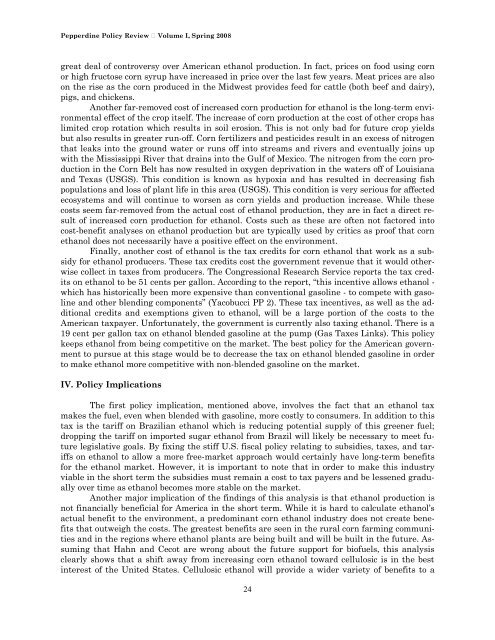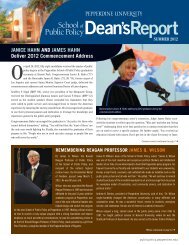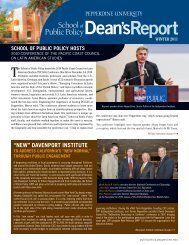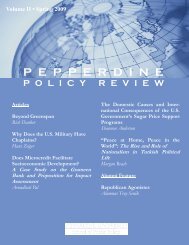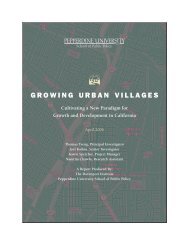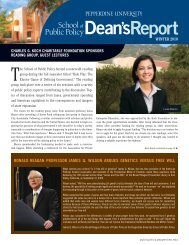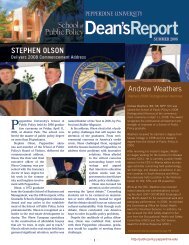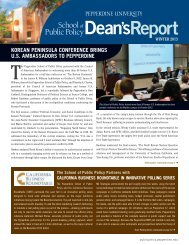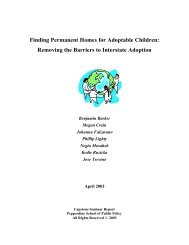Pepperdine University School of Public Policy
Pepperdine University School of Public Policy
Pepperdine University School of Public Policy
Create successful ePaper yourself
Turn your PDF publications into a flip-book with our unique Google optimized e-Paper software.
<strong>Pepperdine</strong> <strong>Policy</strong> Review Volume I, Spring 2008<br />
great deal <strong>of</strong> controversy over American ethanol production. In fact, prices on food using corn<br />
or high fructose corn syrup have increased in price over the last few years. Meat prices are also<br />
on the rise as the corn produced in the Midwest provides feed for cattle (both beef and dairy),<br />
pigs, and chickens.<br />
Another far-removed cost <strong>of</strong> increased corn production for ethanol is the long-term environmental<br />
effect <strong>of</strong> the crop itself. The increase <strong>of</strong> corn production at the cost <strong>of</strong> other crops has<br />
limited crop rotation which results in soil erosion. This is not only bad for future crop yields<br />
but also results in greater run-<strong>of</strong>f. Corn fertilizers and pesticides result in an excess <strong>of</strong> nitrogen<br />
that leaks into the ground water or runs <strong>of</strong>f into streams and rivers and eventually joins up<br />
with the Mississippi River that drains into the Gulf <strong>of</strong> Mexico. The nitrogen from the corn production<br />
in the Corn Belt has now resulted in oxygen deprivation in the waters <strong>of</strong>f <strong>of</strong> Louisiana<br />
and Texas (USGS). This condition is known as hypoxia and has resulted in decreasing fish<br />
populations and loss <strong>of</strong> plant life in this area (USGS). This condition is very serious for affected<br />
ecosystems and will continue to worsen as corn yields and production increase. While these<br />
costs seem far-removed from the actual cost <strong>of</strong> ethanol production, they are in fact a direct result<br />
<strong>of</strong> increased corn production for ethanol. Costs such as these are <strong>of</strong>ten not factored into<br />
cost-benefit analyses on ethanol production but are typically used by critics as pro<strong>of</strong> that corn<br />
ethanol does not necessarily have a positive effect on the environment.<br />
Finally, another cost <strong>of</strong> ethanol is the tax credits for corn ethanol that work as a subsidy<br />
for ethanol producers. These tax credits cost the government revenue that it would otherwise<br />
collect in taxes from producers. The Congressional Research Service reports the tax credits<br />
on ethanol to be 51 cents per gallon. According to the report, “this incentive allows ethanol -<br />
which has historically been more expensive than conventional gasoline - to compete with gasoline<br />
and other blending components” (Yacobucci PP 2). These tax incentives, as well as the additional<br />
credits and exemptions given to ethanol, will be a large portion <strong>of</strong> the costs to the<br />
American taxpayer. Unfortunately, the government is currently also taxing ethanol. There is a<br />
19 cent per gallon tax on ethanol blended gasoline at the pump (Gas Taxes Links). This policy<br />
keeps ethanol from being competitive on the market. The best policy for the American government<br />
to pursue at this stage would be to decrease the tax on ethanol blended gasoline in order<br />
to make ethanol more competitive with non-blended gasoline on the market.<br />
IV. <strong>Policy</strong> Implications<br />
The first policy implication, mentioned above, involves the fact that an ethanol tax<br />
makes the fuel, even when blended with gasoline, more costly to consumers. In addition to this<br />
tax is the tariff on Brazilian ethanol which is reducing potential supply <strong>of</strong> this greener fuel;<br />
dropping the tariff on imported sugar ethanol from Brazil will likely be necessary to meet future<br />
legislative goals. By fixing the stiff U.S. fiscal policy relating to subsidies, taxes, and tariffs<br />
on ethanol to allow a more free-market approach would certainly have long-term benefits<br />
for the ethanol market. However, it is important to note that in order to make this industry<br />
viable in the short term the subsidies must remain a cost to tax payers and be lessened gradually<br />
over time as ethanol becomes more stable on the market.<br />
Another major implication <strong>of</strong> the findings <strong>of</strong> this analysis is that ethanol production is<br />
not financially beneficial for America in the short term. While it is hard to calculate ethanol’s<br />
actual benefit to the environment, a predominant corn ethanol industry does not create benefits<br />
that outweigh the costs. The greatest benefits are seen in the rural corn farming communities<br />
and in the regions where ethanol plants are being built and will be built in the future. Assuming<br />
that Hahn and Cecot are wrong about the future support for bi<strong>of</strong>uels, this analysis<br />
clearly shows that a shift away from increasing corn ethanol toward cellulosic is in the best<br />
interest <strong>of</strong> the United States. Cellulosic ethanol will provide a wider variety <strong>of</strong> benefits to a<br />
24


